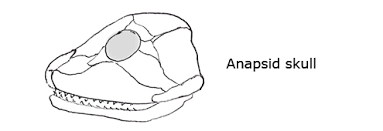Of Holes in Skulls
- tyker21
- Jan 2, 2020
- 2 min read
Skulls are basically round spheres with lots of holes. Each hole has a special function. The nasal fenestra has the nasal cavity, the orbital fenestra is the cavity for eyes, etc.
See, they look exactly the same.
One such type of holes are the temporal fenestrae. These are openings in the skull of a vertebrate which serve multiple purposes: lightening up the skull, providing points for muscle attachment and increasing bite force. There are two types of temporal fenestrae found in vertebrate skulls: upper and lower, located respectively above and below the postorbital and squamosal bones.

Several fenestra. Observe the location of the temporal fenestra
More than muscle attachments or bite force, these openings are critical to taxonomists for classifying reptiles, birds and mammals. There are three groups based on the number of temporal fenestrae: ones with two opening (diapsids), ones with none (anapsids), others some have just one (synapsids).

Anapsids
Anapsids have no temporal fenestra in their skulls. As seen in the figure below, an anapsid skull lacks any opening between the post-orbital (po) and squamous (sq) bones. Since most animals present today have multiple openings, having no holes is considered to be a primitive feature.
An example of an extant anapsid is the loggerhead turtle with it's surprisingly bird like skull lacking any holes completely (bottom figure). Turtles, tortoises and other testudines is the only group of animals alive today that have a fully anapsid skull. They were also thought to be
Diapsids have both the temporal fenestra in their skulls, lodged above and below the articulation of the post-orbital and squamous bones (as seen in the left figure below).
An example of this type of creature are crocodilians, whose flattened shape make it easy to catch fish or other prey in the marshy lands which they rule. This flattened shape necessitates a top view of the skull which showcases the two fenestrae. Other related organisms, like dinosaurs, birds, pterosaurs, lizards and snakes also have a similar or slightly derived skull structure. Turtles are also in fact, diapsids which have lost both the openings.
Snakes, lizards and birds also have derived skulls but descended from diapsid creatures hence are grouped as such. Lizards have one hole while snakes have lost both holes, similar to turtles. Birds have a heavily modified skull which can not really get placed in this classification scheme.
Synapsids have the lower temporal fenestra in their skulls as seen in the left figure below. In addition to having holes in the bottom of the po and sq bones, synapsid skulls also show a variation in the length, shape and size of the teeth.
In recap
Terrestrial vertebrate skulls come with holes in a variety of shapes and sizes, but the temporal fenestra are the most important when it comes to taxonomy. Anapsids have no fenestra, diapsids have two while the synapsids have one (lower). Some animals revert back to having one hole (lizards) or no holes (snakes and turtles).














Comments